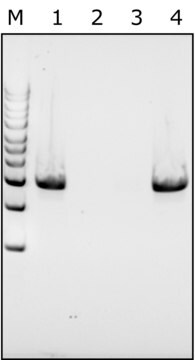L7773
Lysozyme from chicken egg white
aseptically filled
Synonym(s):
Mucopeptide N-acetylmuramoylhydrolase, Muramidase
Sign Into View Organizational & Contract Pricing
All Photos(1)
About This Item
CAS Number:
EC Number:
MDL number:
UNSPSC Code:
12352204
NACRES:
NA.54
Recommended Products
sterility
aseptically filled
Quality Level
form
powder
enzyme activity
≥40000 units/mg protein
mol wt
single-chain 14.3 kDa
UniProt accession no.
storage temp.
−20°C
Gene Information
chicken ... LYZ(396218)
Looking for similar products? Visit Product Comparison Guide
Application
Enzyme breaks down the cell walls of bacteria; used to prepare spheroplasts.
Biochem/physiol Actions
Lysozyme hydrolyzes β(1→4) linkages between N-acetylmuramic acid and N-acetyl-D-glucosamine residues in peptidoglycan and between N-acetyl-D-glucosamine residues in chitodextrin. Gram-positive cells are quite susceptible to this hydrolysis as their cell walls have a high proportion of peptidoglycan. Gram-negative bacteria are less susceptible due to the presence of an outer membrane and a lower proportion of peptidoglycan. However, these cells may be hydrolyzed in the presence of EDTA that chelates metal ions in the outer bacterial membrane.
The enzyme is active over a broad pH range (6.0 to 9.0). At pH 6.2, maximal activity is observed over a wider range of ionic strengths (0.02 to 0.100 M) than at pH 9.2 (0.01 to 0.06 M).
The enzyme is active over a broad pH range (6.0 to 9.0). At pH 6.2, maximal activity is observed over a wider range of ionic strengths (0.02 to 0.100 M) than at pH 9.2 (0.01 to 0.06 M).
Unit Definition
One unit will lyse 0.6 μg of Micrococcus lysodeikticus per minute by turbidimetric detection at 600 nm when suspended in buffer at pH 6.2 at 25 °C.
Preparation Note
Prepared from L6876
Other Notes
View more information on enzymes for complex carbohydrate analysis at www.sigma-aldrich.com/enzymeexplorer
Signal Word
Danger
Hazard Statements
Precautionary Statements
Hazard Classifications
Resp. Sens. 1
Storage Class Code
11 - Combustible Solids
WGK
WGK 3
Flash Point(F)
Not applicable
Flash Point(C)
Not applicable
Personal Protective Equipment
dust mask type N95 (US), Eyeshields, Gloves
Certificates of Analysis (COA)
Search for Certificates of Analysis (COA) by entering the products Lot/Batch Number. Lot and Batch Numbers can be found on a product’s label following the words ‘Lot’ or ‘Batch’.
Already Own This Product?
Find documentation for the products that you have recently purchased in the Document Library.
Customers Also Viewed
Mariela G Del Giudice et al.
Infection and immunity, 81(3), 956-964 (2013-01-16)
Secretion of proteins in Gram-negative bacteria is a high-energy-consuming process that requires translocation across two membranes and a periplasmic space composed of a mesh-like layer, the peptidoglycan. To achieve this, bacteria have evolved complex secretion systems that cross these barriers
Anne Derbise et al.
The Journal of infectious diseases, 207(10), 1535-1543 (2013-02-14)
Yersinia pestis (the plague bacillus) and its ancestor, Yersinia pseudotuberculosis (which causes self-limited bowel disease), encode putative homologues of the periplasmic lysozyme inhibitor Ivy and the membrane-bound lysozyme inhibitor MliC. The involvement of both inhibitors in virulence remains subject to
P F Zabrodskiĭ et al.
Eksperimental'naia i klinicheskaia farmakologiia, 75(11), 19-21 (2013-01-18)
It is established in experiments on noninbred rats that the use of imunofan (20 mg/kg daily) and polyoxidonium (150 mg/kg daily) for 7 days on the background of chronic intoxication with organophosphorus agent VX (0.01 LD50, single daily treatment for
Andrea Weeks et al.
Eye & contact lens, 39(2), 179-185 (2013-02-16)
This study was designed to assess the duration of hyaluronic acid (HA) release from model contact lens materials when HA was physically incorporated into the hydrogel during synthesis and to assess the effects of the HA release on lysozyme sorption.
Agnieszka Zdybicka-Barabas et al.
Biochimica et biophysica acta, 1828(6), 1449-1456 (2013-02-20)
Insect immune response relies on the humoral and cellular mechanisms of innate immunity. The key factors are the antimicrobial polypeptides that act in concert against invading pathogens. Several such components, e.g. apolipophorin III (apoLp-III), lysozyme, and anionic peptide 2, are
Our team of scientists has experience in all areas of research including Life Science, Material Science, Chemical Synthesis, Chromatography, Analytical and many others.
Contact Technical Service






